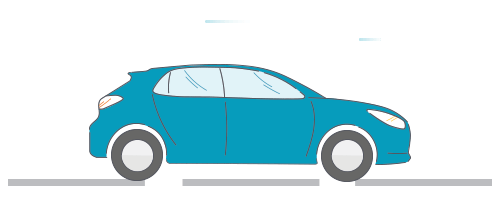Air pollution affects the health of people across Ireland. According to The European Environment Agency, it is estimated more than 400,000 premature deaths are attributable to poor air quality in Europe annually.
Although the Environment Protection Agency states that Ireland’s overall air quality is currently good, relative to other EU Member States, our premature deaths attributable to air pollution are still estimated at 1,300 people.
The World Health Organisation (WHO) has described air pollution as the ‘single biggest environmental health risk’. WHO gives this advice for ways to reduce breathing polluted air:
Limit walking on busy streets during rush hour, and if you have a young child with you, try and lift them above the level of vehicle exhausts
Limit spending time at specific hotspots of traffic, such as cars stopped at traffic lights
When you’re doing physical activity outdoors, try exercising in less polluted areas
Limit the use of cars on highly polluted days
Don’t burn waste, as the smoke that results damages our health
CO2 accounts for over 75% of the world’s air pollution. Transport is responsible for around a quarter of all CO2 emissions, with road vehicles being the main contributor.
Here in Ireland, despite our monitored air quality generally being within EU limit values, the levels of particulate matter is of growing concern, particularly in urban areas. Although new EU emissions standards for vehicles, cleaner technology and a reduction in the number of vehicles using the roads has all helped reduce air pollution, the Environment Protection Agency has stated that we still face exceeding these limits unless we reduce our dependence on the private motor car.
Managing vehicle emissions is key to tackling air quality.
Ireland’s Air Quality is measured within 4 ‘Zones’: Dublin, Cork, all other major towns and cities, and lastly all rural areas. The Environment Protection Agency provides information on these Zones and their air monitoring locations.
Due to the vast differences in air quality around the country, one approach does not work across the board.
Many EU countries have had to introduce Clean Air Zones to tackle heavily polluted urban areas, but as yet Ireland has not had to implement one of these localised schemes. However, Dublin’s local authorities are in the process of preparing an ‘Air Quality Action Plan’ to address the exceedance of nitrogen dioxide levels in the city. The Department of the Environment, Climate and Communications is working with the Department of Transport on Urban Transport Related Air Pollution and it may be that a Clean Air Zone is recommended following the results of their work.
There are also a number of community-led campaigns across the country tackling issues such as idling close to schools and other transport-related pollution problems. The Clean Air Day campaign has also seen wide support.
A Clean Air Zone, or Low Emission Zone, is an area where targeted action is taken to improve air quality. There are often charges to drive in the zones. Whether a vehicle is charged usually depends on the type of vehicle, what it is being used for and its level of emissions.
The Environmental Protection Agency is clear that we all have a role to play in improving the quality of the air we breathe. Our transport choices directly influence the level of pollution in the air around us. So, switching to cleaner forms of transport, using public transport or carpooling to commute will all help. As well as walking or cycling whenever we can of course.
The Environmental Protection Agency’s Air Quality Index for Health allows you to easily check the air quality nearest to you, with updated stats every two to five minutes. The map shows ratings from 1 to 10, with a reading of one to three inclusive meaning that the air quality is good, and a reading of 10 meaning the air quality is very poor.
The latest information on vehicle emissions can be found on the Road Safety Authority’s website.
The European Commission has a ‘Green Driving Tool’ to help you reach each destination through the most fuel efficient route, monitor your fuel expenses and compare CO2 emissions among different cars.
The UK’s transport department also has a handy online tool for checking emissions of new cars. (Only cars registered in the UK can search for emissions data for used vehicles).
If you’re thinking of switching to a more environmentally-friendly vehicle, it’s always worth checking if your preferred car manufacturers have a scrappage scheme running for old vehicles.
The government is not currently running a country-wide scrappage scheme to incentivise the purchase of new cars with low emissions, but you’ll be sure to hear from us first if anything changes!
There will always be a local CarTakeBack recycling centre that can help with the responsible recycling of your old car. You can start with our instant quote service and your car will be collected by a local CarTakeBack branch.




